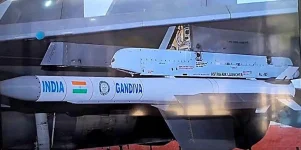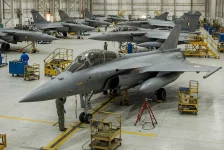- Views: 1K
- Replies: 7

The Indian Air Force (IAF) is planning a significant upgrade to its MiG-29 UPG fighter jets, equipping them with advanced avionics, control systems, and the formidable Israeli Rampage missiles. This enhancement aims to substantially elevate the fleet's ground attack capabilities and overall combat effectiveness.
Initially, 24 MiG-29 UPGs will be modified to integrate the Rampage missile, designated as High-Speed Low Drag (HSLD) Mk-II in IAF service. These missiles boast an impressive range exceeding 180 kilometers, granting the fighter jets the ability to engage targets from a safe distance.
The integration process entails extensive modifications to the jets, including the design and installation of new bomb racks, additional cabling, and software development to accommodate the missile's unique requirements.
The Rampage missile, derived from the EXTRA rocket developed by Israel Aerospace Industries (IAI), was originally conceived for ground-based multi-launch rocket systems but has been adapted for air-to-surface deployment. This ground-launched heritage translates to easier manufacturing and cost-effectiveness compared to traditional cruise and ballistic missiles.
Leveraging an INS/GPS kit for precise targeting, the Rampage provides a crucial standoff capability, allowing fighter jets to launch attacks from well beyond the reach of enemy air defenses. Its maneuverability, high terminal velocity, and quasi-ballistic trajectory make it an elusive target for interception, enabling the penetration of dense air defense networks and the destruction of heavily fortified targets.
The Indian Navy already employs Rampage missiles on its MiG-29K carrier-based jets, and the IAF has also integrated them onto its Sukhoi Su-30 MKI and Jaguar fighter bombers.
In addition to the Rampage, the IAF is also utilizing another Israeli missile, the Rafael-developed ROCKS, on its Su-30 MKI fleet. Known as Crystal Maze 2 within the IAF, ROCKS is an air-launched ballistic missile (ALBM) with a range exceeding 250 kilometers.
Like the Rampage, ROCKS originates from a ground-launched ballistic missile adapted for aerial deployment. The IAF intends to procure a large quantity of these missiles and initiate domestic production in India.
Notably, ROCKS has demonstrated its effectiveness in bypassing Iranian air defenses, successfully targeting the S-300 30N6E target engagement radar, a system ironically designed to counter such missiles.
Beyond these missile upgrades, the IAF is also contemplating a mid-life extension program for its entire MiG-29 fleet, potentially extending their operational lifespan from 40 to 50 years. This move would ensure the continued service of these jets beyond 2025, contributing to the IAF's overall combat readiness.




